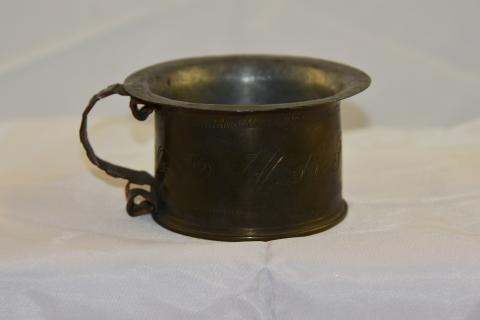This is a coffee cup made out of a 16cm German artillery shell (presumably) fired during the First World War. The cup is formed out of the salvaged outer casing of an artillery shell which was either recovered after an engagement or scrapped before use. Engravings on the bottom of the shell denote its size and other specifications. The inscription "16 C" is the primary indication that this was originally a 16-centimeter shell used by the German Army. It would have been intended for use by a German field gun crew for preparing enemy trenches for assault or for softening land-based targets. The top of the cup has been flared outward to form a circular bill around the rim for easy drinking. A crude iron handle has been attached to the side of the cup, which now shows signs of contact rusting. The ornate engraving on the side of the cup reads, "W.H.R. - Verdun 1917." The first three letters likely reflect the initials of the individual who owned this item, while the phrase "Verdun 1917" indicates that they either served in the Battle of Verdun (February - December 1916) or the cup was made to commemorate the battle. The intricate style and quality of craftsmanship shown on this item suggests that the work was done after the war was finished or after its owner returned from active duty; the quality is too high for a work that could have been completed in the field by a non-professional metalworker. This content can be used with the following resources: SS-WH.9-12.26: Iowans Influence World History This content can be used to educate students on how the arts and culture evolved during the First World War and the role that Iowans and other American servicemen may have had in shaping the artistic and cultural landscapes of the time. For any use other than instructional resources, please check with the organization that owns this item for any copyright restrictions.
2018.002.026 [Cup, Coffee]
Legal Status
Copyright to this resource is held by the Iowa Masonic Library and Museum and has been provided here for educational purposes only, specifically for use in the Iowa Museum Association's "Teaching Iowa History" project. It may not be downloaded, reproduced or distributed in any format without written permission from the Rights Holder. For more information on U.S. and International copyright laws, consult an attorney.

